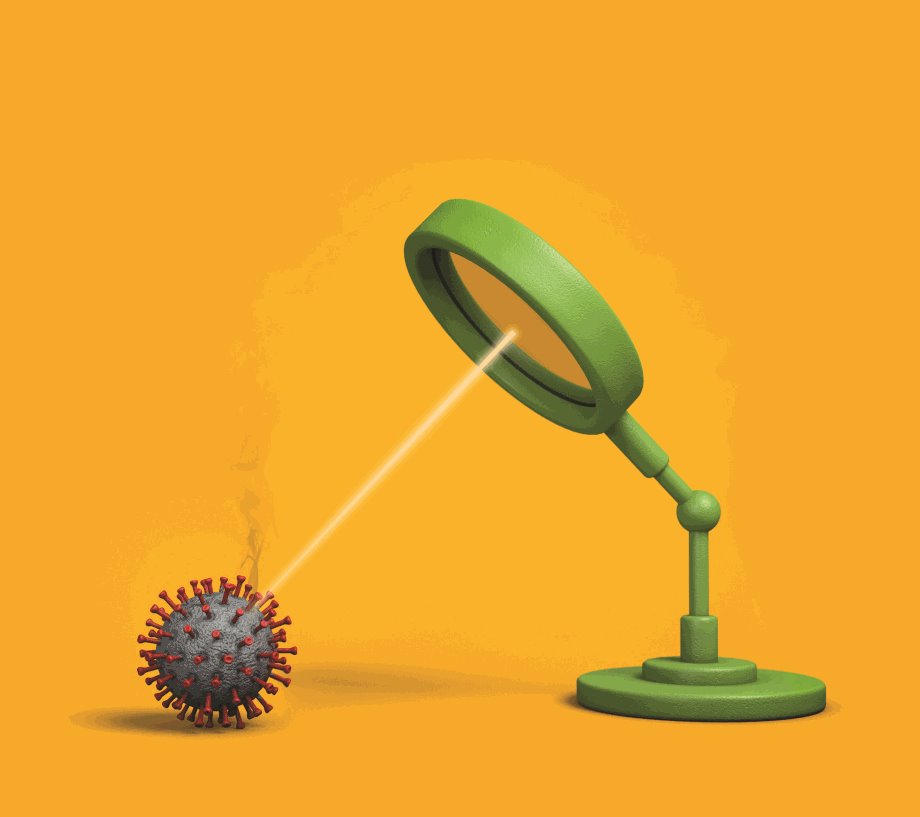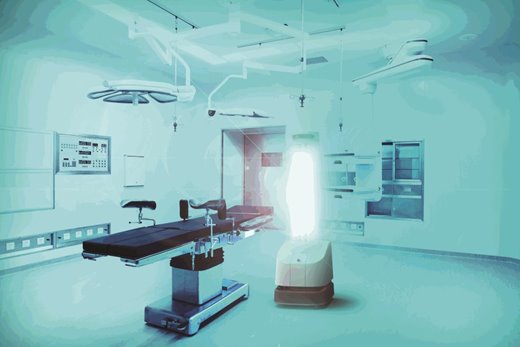The Power of Light to Fight Bacteria
The Power of Light to Fight Bacteria


This year's Emerging Tech Award Winner UVD Robots uses UV-C light and advanced machine learning to create an autonomous disinfecting service robot. Illustration: Richard Borge
When the COVID-19 pandemic broke out in China in early 2020, the autonomous disinfecting robots from UVD Robots saw massive interest from companies looking to sanitize and sterilize their places of business.
“We already had steep growth in 2018 and 2019, close to 400 percent annually. We had a plan in place to ramp up production, sales, and customer support to meet demand,” said Claus Risager, the CEO of Blue Ocean Robotics and founder of UVD Robots. “But then, when the coronavirus hit, the growth tripled in a matter of months.”
UVD Robots is a subsidiary company of Blue Ocean Robotics, headquartered in Odense, Denmark. Risager learned through a medical colleague at a local university how antibiotic-resistant bacteria is one of the leading causes of patient infections in hospitals.
Checkout Our Video: Killing the Coronavirus with Disinfection Robots
“The patients were getting infections in the hospital and staying there longer and longer,” said Risager. “They had quite a number of deaths as a result, and the medical community was asking what could be done about this.”
The result was the creation of the first autonomous robot equipped with UV-C light to kill bacteria.
Read Our Robotics Blog: Making Robots Ubiquitous Post-Pandemic
“UV-C as a manual disinfection process has been known for more than 10 years, but no one was integrating UV-C light with an intelligent autonomous robot,” said Per Juul Nielsen, CEO of UVD Robots. Nielsen had the task of taking the company public and to educate the market on the benefits of a UV-C disinfecting robot.
UV-C light is blocked out by the Earth’s atmosphere and is exceptionally effective against bacteria and viruses. When the light penetrates the cell membranes, it destroys the DNA and RNA structures of any micro-organism, stopping its reproduction and sterilizing the environment. Up to 99.99 percent of all bacteria is eliminated.
The challenge of using UV-C light is that it must be in close proximity to the surfaces (about a 1-meter distance) to work appropriately. This is why UVD Robots took the autonomous approach.
The UVD robot operates autonomously by navigating hospital corridors and rooms by via pre-mapped layouts. The operator can use a smartphone or tablet to direct the robot into the appropriate room and run the disinfection program. The robot can automatically detect surfaces and ensure the proper UV-C light exposure across the given area.
The robot also has “intelligent UV-C” capabilities. Once the disinfection is complete, it scans and measures the room to report on its effectiveness. All in all, it takes about 10 to 12 minutes to properly disinfectant a room, and 15 to 20 minutes for a larger space like an operating theater.
Take Our Quiz: How Are Robots Helping Combat COVID-19?
The future for UVD Robots is to expand beyond the healthcare industry.
“We are now expanding into 20 new market segments,” said Risager. “Our robots are being used by in-home care facilities, schools, airports, airlines, hotels, pharmaceutical plants, and food and beverage companies. The list is quite long.”
According to Nielsen, the disinfecting robots provide an essential safety service. “Anywhere people are gathered, and they want to make sure that the environment is safe and sound for people to operate in, our robots can be found there.”
Carlos M. González is special projects manager.
See who the other winners are in Video: 2020 Emerging Technology Awards
“We already had steep growth in 2018 and 2019, close to 400 percent annually. We had a plan in place to ramp up production, sales, and customer support to meet demand,” said Claus Risager, the CEO of Blue Ocean Robotics and founder of UVD Robots. “But then, when the coronavirus hit, the growth tripled in a matter of months.”
UVD Robots is a subsidiary company of Blue Ocean Robotics, headquartered in Odense, Denmark. Risager learned through a medical colleague at a local university how antibiotic-resistant bacteria is one of the leading causes of patient infections in hospitals.
Checkout Our Video: Killing the Coronavirus with Disinfection Robots
“The patients were getting infections in the hospital and staying there longer and longer,” said Risager. “They had quite a number of deaths as a result, and the medical community was asking what could be done about this.”
The result was the creation of the first autonomous robot equipped with UV-C light to kill bacteria.
Read Our Robotics Blog: Making Robots Ubiquitous Post-Pandemic
“UV-C as a manual disinfection process has been known for more than 10 years, but no one was integrating UV-C light with an intelligent autonomous robot,” said Per Juul Nielsen, CEO of UVD Robots. Nielsen had the task of taking the company public and to educate the market on the benefits of a UV-C disinfecting robot.
UV-C light is blocked out by the Earth’s atmosphere and is exceptionally effective against bacteria and viruses. When the light penetrates the cell membranes, it destroys the DNA and RNA structures of any micro-organism, stopping its reproduction and sterilizing the environment. Up to 99.99 percent of all bacteria is eliminated.
The challenge of using UV-C light is that it must be in close proximity to the surfaces (about a 1-meter distance) to work appropriately. This is why UVD Robots took the autonomous approach.
The UVD robot operates autonomously by navigating hospital corridors and rooms by via pre-mapped layouts. The operator can use a smartphone or tablet to direct the robot into the appropriate room and run the disinfection program. The robot can automatically detect surfaces and ensure the proper UV-C light exposure across the given area.
The robot also has “intelligent UV-C” capabilities. Once the disinfection is complete, it scans and measures the room to report on its effectiveness. All in all, it takes about 10 to 12 minutes to properly disinfectant a room, and 15 to 20 minutes for a larger space like an operating theater.
Take Our Quiz: How Are Robots Helping Combat COVID-19?
The future for UVD Robots is to expand beyond the healthcare industry.
“We are now expanding into 20 new market segments,” said Risager. “Our robots are being used by in-home care facilities, schools, airports, airlines, hotels, pharmaceutical plants, and food and beverage companies. The list is quite long.”
According to Nielsen, the disinfecting robots provide an essential safety service. “Anywhere people are gathered, and they want to make sure that the environment is safe and sound for people to operate in, our robots can be found there.”
Carlos M. González is special projects manager.
See who the other winners are in Video: 2020 Emerging Technology Awards




